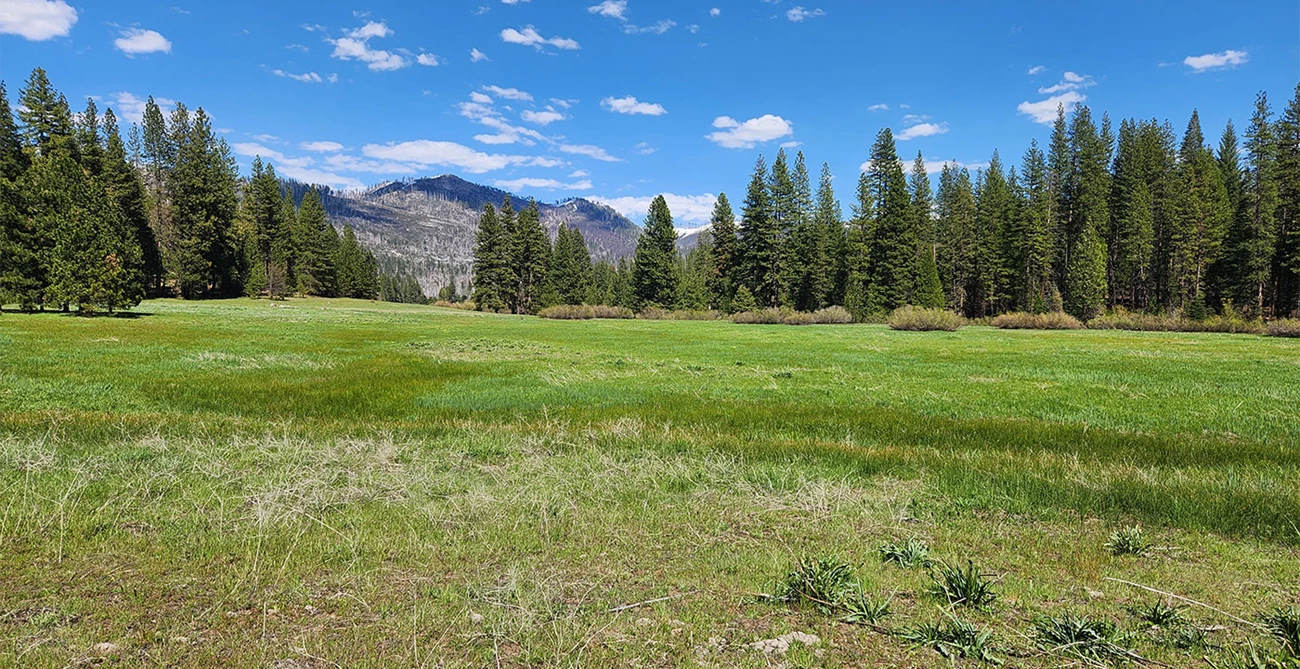
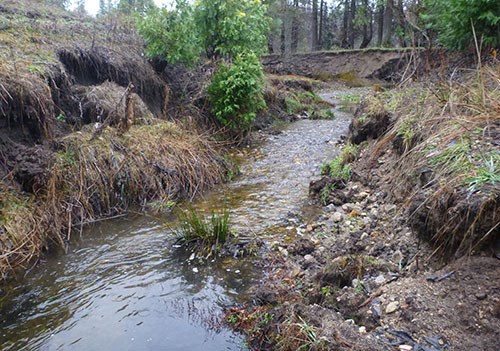
OverviewAckerson Meadow is one of the largest mid-elevation meadows in the Sierra Nevada, and the largest in Yosemite National Park. It is an ecologically and regionally critical wildlife corridor and the scenic meadow is an important habitat for the State endangered great grey owl and little willow flycatcher, as well as a suite of additional at-risk wildlife species. It was purchased from private ownership in 2016 and donated to Yosemite by a coalition including the Trust for Public Lands, National Park Trust, Yosemite Conservancy, and American Rivers. A large erosion gully network, up to 2 miles long, 14 feet deep, and 100 feet wide, has drained 90 acres of wetlands in the meadow and was actively eroding an additional 100 acres of remaining wetlands and wet meadow habitat. The gully network was a result of over a century of landscape manipulation including domestic water diversion, farming, ranching, and timber harvest. Yosemite National Park and Stanislaus National Forest partnered with American Rivers and Yosemite Conservancy to implement actions that reduce erosion and restore wetland functionality at Ackerson Meadow. Additional goals of the project were to:

Restoration Project HighlightsWetland and floodplain restoration is important for water quality and supply, flood protection, resilience to drought, wildfire protection, recreation, wildlife habitat, and soil health. Wetland restoration is a priority for the National Park Service and State of California. In June 2025, the project team completed implementation of the largest wetland restoration project in Yosemite's history, and the largest wetland restoration project, by fill volume, to date within the Sierra Nevada. National Park Service staff and project partners began formal designs and planning for this project between 2018 and 2022. The project was implemented between August 2023 and June 2025. The plan's full fill preferred alternative (i.e.., filling the erosion gully to the elevation of the surrounding meadow) was selected by the project team because it provided rapid and comprehensive restoration of the wetland area lost to human impacts, it protected the remaining intact wetlands, and is anticipated to become a self-sustaining ecosystem in 3-5 years, resulting in the least expected maintenance needs over the long-term. During this project, the team filled 18,538 linear feet (3.51 miles) of erosion gully with 162,000 cubic yards of locally sourced material (132,900 cubic yards of mineral soil combined with 29,100 cubic yards of woodchips). Benefits provided by this project include the restoration of wetland hydrology to 94 acres of former wetlands and protection of an additional 84 acres of existing wetlands. Revegetation of the restored meadow surface (e.g., 28.08 acres of area with placed fill, plus 0.43 acres of access routes) included broadcast seed of more than 117 pounds of native locally-collected seed from 25 native plant species, installation of 434,000 wetland container plants (including Scirpus microcarpus, Juncus dubius, J. balticus, Carex athrostachya, C. nebrascensis, and C. pellita), and harvest and re-planting of wetland sod and 600 whole-plant willows on the restored meadow surface. The 15.11 acres of borrow area were restored by broadcast seeding, mulching, and planting 170 locally-sourced nursery-grown black oak (Quercus kelloggii) saplings. This project provides outstanding long-term benefits to rare species including: the Pacific fisher (Federally Endangered), Northwest Pond Turtle (proposed Federally Threatened), Great Grey Owl (CA Endangered), and Little Willow Flycatcher (CA Endangered). The project will also benefit a diverse suite of native songbirds. Additionally, this project increased water security and forage production on Unite States Forest Service-administered lands. This monumental project is possible due to the collaborative partnership of American Rivers, National Park Service (Yosemite National Park), United States Forest Service (USFS) Stanislaus National Forest, and the Yosemite Conservancy (listed alphabetically). FundingThis project was funded in part by the donors of American Rivers, Bonneville Environmental Foundation, California Department of Fish and Wildlife, California Wildlife Conservation Board, Google (in association with their Water Stewardship pledge and strategy), National Park Foundation (provided by The Coca-Cola Company, The Coca-Cola Foundation, and Stericycle), National Park Service (provided by Bipartisan Infrastructure Law-Ecosystem Restoration, Concessions Franchise Fee, and NPS Operations), US Forest Service, and the Yosemite Conservancy (listed alphabetically). This project was supported by services from Cornflower Farms, Evan Wolf LLC, Hanford Applied Restoration and Conservation, Institute for Bird Populations, Randy Westmoreland Consulting, Stantec, and the Upper Colorado Center for Plant Diversity (listed alphabetically). 
Implementation Timeline and PartnershipsRestoration implementation for this project was planned between late summer 2023 and spring 2025.Restoration implementation occurred in two distinct phases, because of the magnitude of the project area. Phase 1 occurred between August and November 2023 followed by revegetation in spring of 2024. Phase 2 occurred between August and November 2024 followed by revegetation in spring of 2025. During phase 1 of this project, activities took place to fill the gully within the lower half of main Ackerson Meadow as well as the full extent of the gully in south Ackerson Meadow and established a rock grade control structure at the downstream end of the project area. Phase 2 work completed the gully fill in main Ackerson Meadow to the top of the meadow. Adaptive management and long-term monitoring are now underway. Completing implementation of the full fill alternative immediately returned self-sustaining hydrologic function to this 230-acre headwater meadow system. This restoration improves water quality and drinking water supply, increases groundwater storage, sequesters high rates of carbon, and improves wildlife habitat. The resulting healthy headwater system increases water security and helps to mitigate the impacts of drought and floods on downstream communities within the Tuolumne River watershed, including the cities of Turlock, Modesto, and others. In addition, the restoration benefits wildlife and multiple endangered species including the Great Gray Owl (North America’s largest owl), little Willow Flycatcher, and northwestern pond turtle. The project helps achieve goals of Executive Order N-82-20 for California State’s 30 by 30 Initiative, and helps the Sierra Meadow Partnership goal to restore 30,000 acres of meadow by 2030. To restore and protect the approximately 190 acres of wetlands and former wetlands at Ackerson Meadow, the team combined 132,900 cubic yards of earthen fill with 29,100 cubic yards of woodchips to fill the gully; totaling over 162,000 cubic yards of locally sourced material to fill the erosion channel. Revegetation of project-related disturbed ground included:
The National Park Service initiated consultation for the Ackerson Meadow Restoration project with the seven associated American Indian tribes and groups in October 2017. Meetings and site visits were conducted throughout the planning and implementation phases. Tribal members participated in revegetation and other opportunities associated with this project. The Yosemite Ancestral Lands tribal conservation crew participated in more than 40 hours of beaver dam analogue development. The Tuolumne Band of Me-Wuk Indians provided qualified tribal monitors for on-site resource protection throughout the construction phases of the project to preserve sensitive tribal resources. Volunteer opportunities remain a high priority for long-term stewardship of the project site. Large numbers volunteers have assisted park staff with tasks, including seed collection, invasive plant treatments, beaver dam analogue installation, and resource monitoring. In 2021 and 2022 combined, 167 volunteers provided 3,145 total hours to support the project. In 2023, 137 volunteers contributed 2,018 total hours. In 2024, 233 volunteers provided 2,933 total hours and in 2025, 44 volunteers provided 689 total hours of work. Before and After Restoration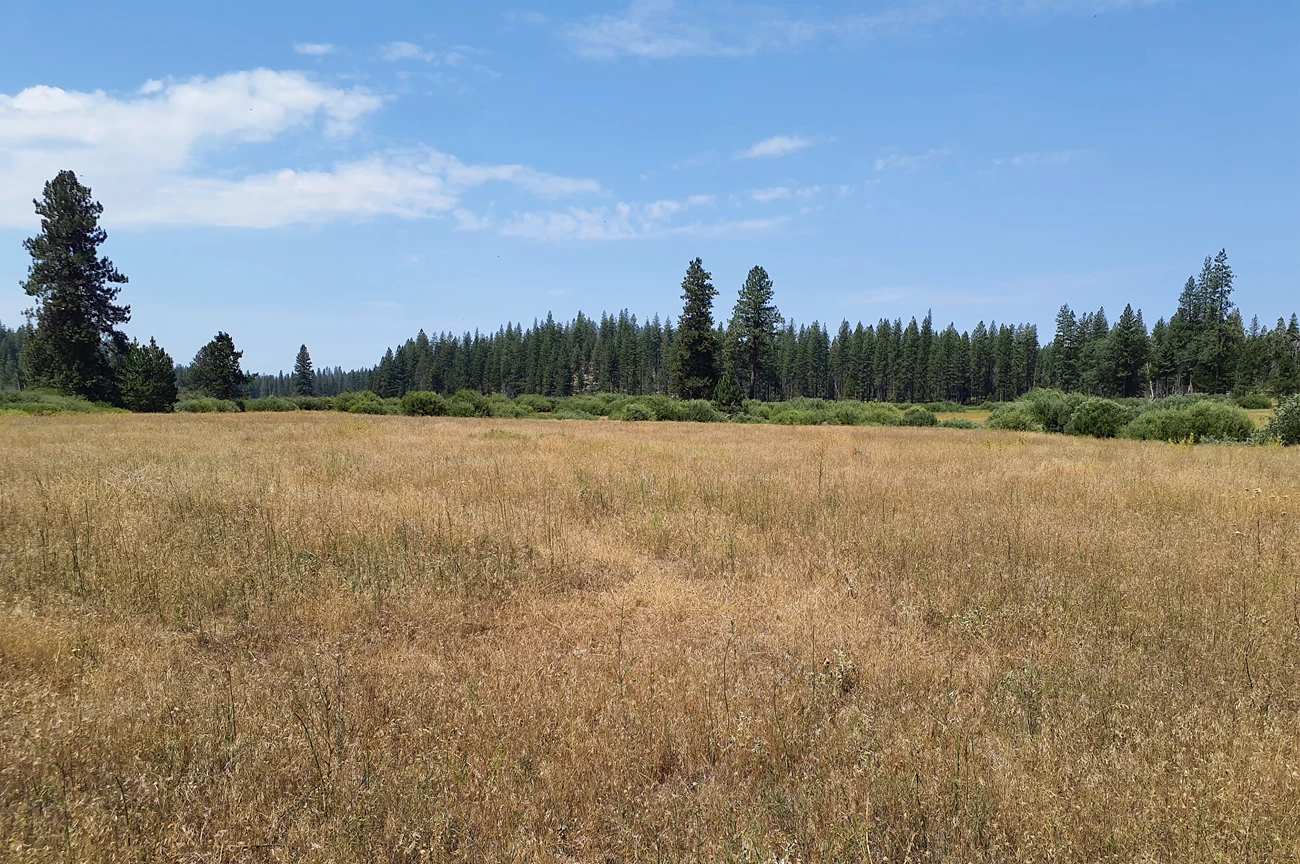
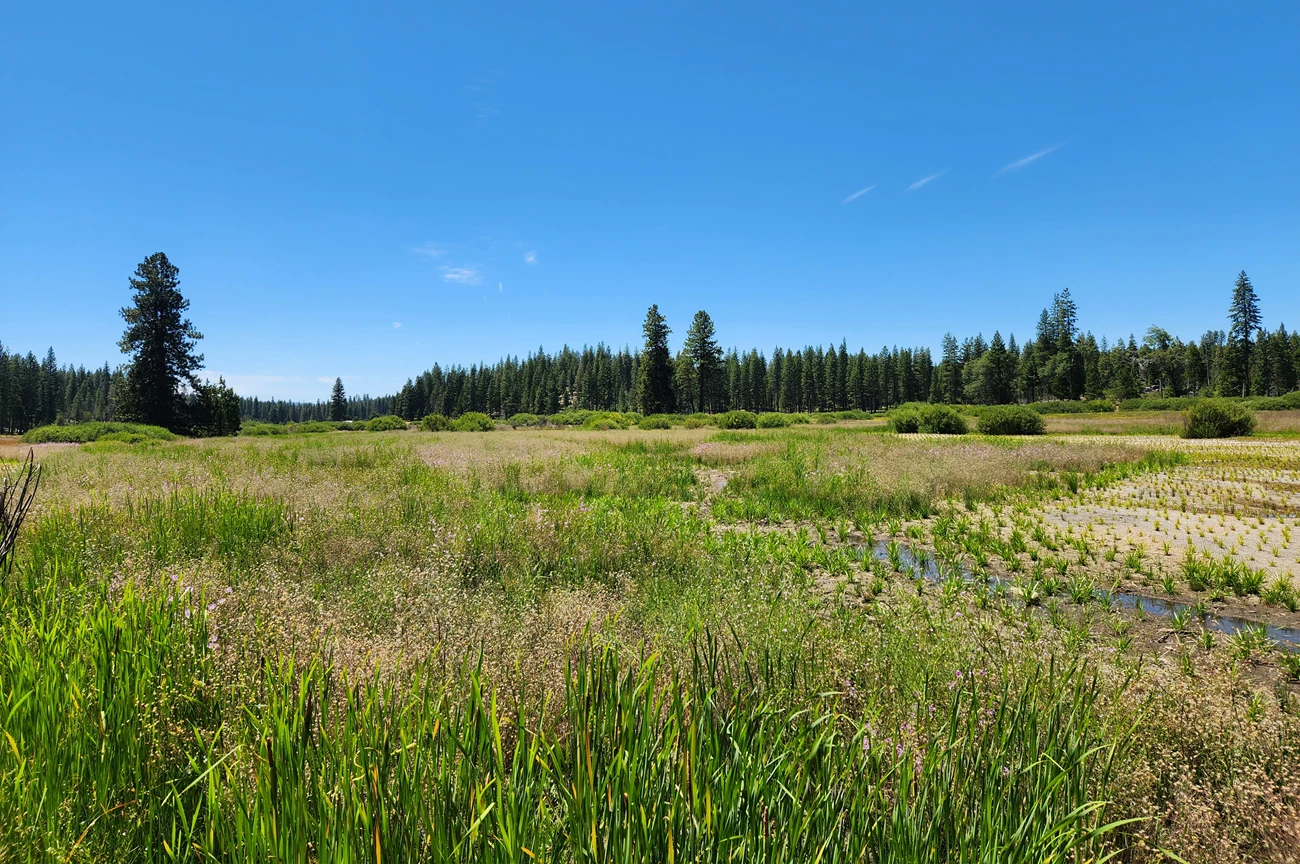
Left image
Right image
ResearchResearch studies at Ackerson Meadow are focused on contributing to wetland restoration science, and comparison of pre– and post-restoration conditions for rare wildlife species. Understanding these behaviors will help inform protection decisions for future restoration or construction projects throughout the region. The United States Geological Survey (USGS) led a study on fine-detail topography, vegetation, and habitat structure change related to restoration, and did a comparison of UAV-collected lidar data wit terrestrial and airborne datasets. Ackerson Meadow is included as a site within USGS-led soil carbon sequestration study to improve the Land Use and Carbon Simulator (LUCAS) to estimate changes in carbon in response to planned restoration and quantifying benefits using data collected from this project. This will result in a decision-support tool to assess carbon sequestration potential of any future wetland restoration project by providing decision-makers with “what-if” management scenarios for possible future changes to management or restoration plans. Project related National Park Service-led resource monitoring includes: long-term vegetation plots, ground and surface water measurements, avian and bat surveys, northwestern pond turtle studies, soil carbon measurements, and archeological and tribal resource surveys. Restoration Video
Visit our keyboard shortcuts docs for details
Ackerson Meadow is one of the largest mid-elevation meadows in the Sierra Nevada, and the largest in Yosemite National Park and is an ecologically and regionally critical wildlife corridor. The Ackerson Meadow Restoration Project is the largest wetland restoration project in Yosemite’s history. It is the largest restoration project, by fill volume, to date within the Sierra Nevada. Learn more about this collaborative undertaking which started in late summer 2023. Planning ProcessIn summer 2020, the park requested input on issues that the planning team should address during the planning process, additional alternatives to meet the purpose of the plan, information the park should consider in the upcoming analysis, and other feedback. Comments were accepted through August 25, 2020. The project team analyzed the public comments from the civic engagement period and refined alternatives for the Ackerson Meadow Restoration Environmental Assessment (EA). The planning team developed three action alternatives to meet the purpose and need of the project. Next an impact analysis of the three alternatives was conducted. Analyzing impacts means considering how the condition of the resources would change, either negatively or positively, as a result of the implementation of the alternatives under consideration. The environmental assessment presented the results of the impact analysis. The Ackerson Meadow Restoration Environmental Assessment underwent public and agency review from June 2, 2021 to July 8, 2021. As mentioned previously, the full fill preferred alternative was selected. A Finding of No Significant Impacts (FONSI) and the Determination of Non-Impairment were signed by the National Park Service on September 21, 2021. Documents
Public Meeting Webinar Recording
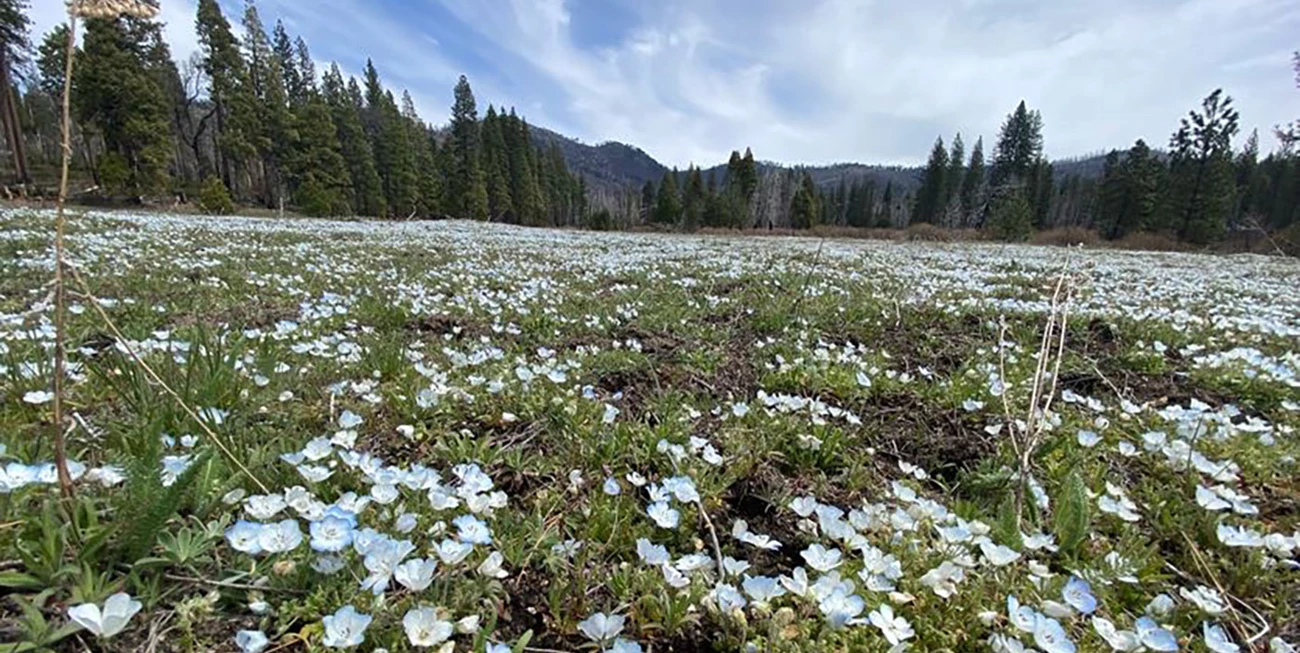
|
Last updated: September 30, 2025

